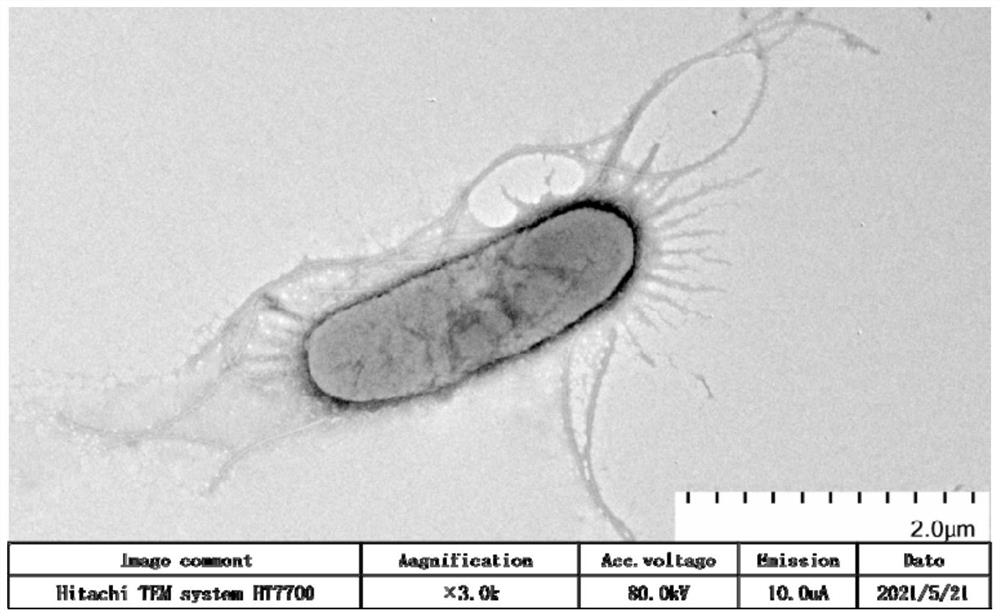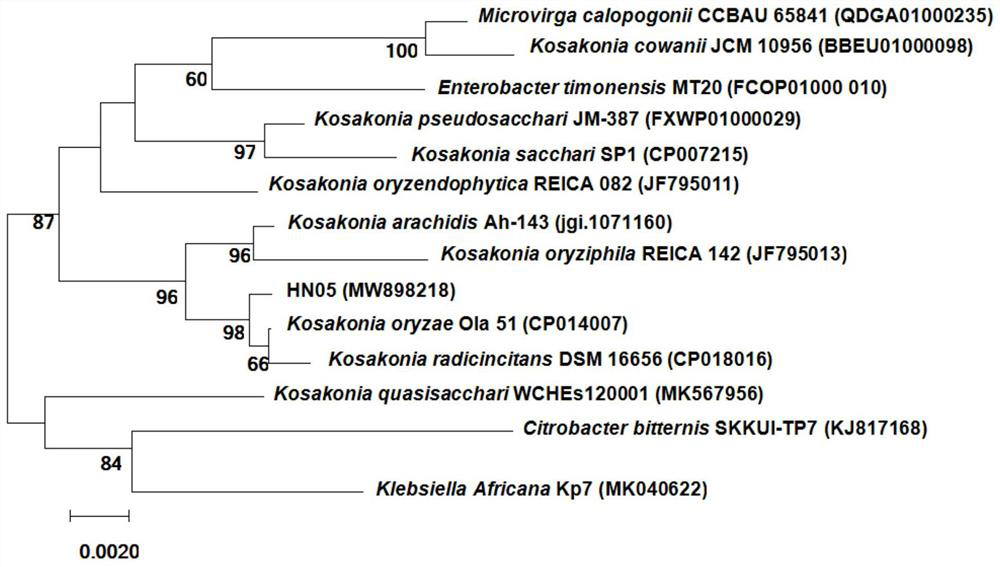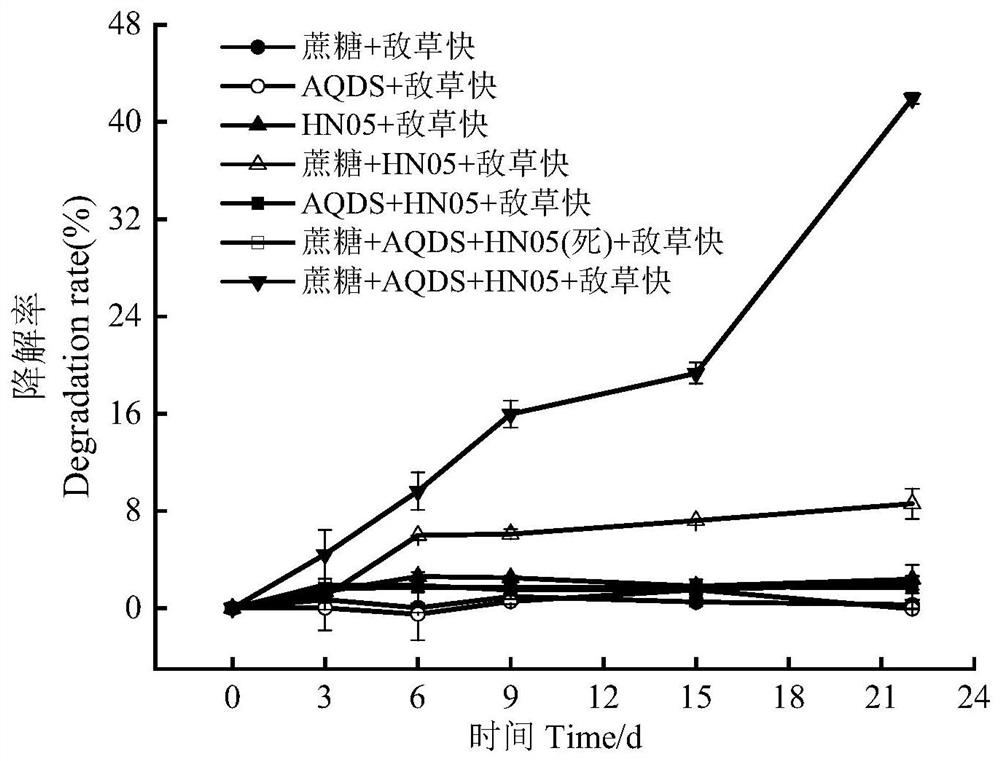Rice kosakonia oryzae HN05 and application thereof
A Saxobacteria sp., M2021956HN05 technology, applied in rice Kossackia sp. HN05 and its application fields, can solve the problems such as no Kosakoniasp. literature reports, achieve good application prospects, promote anaerobic degradation, and broad spectrum of electron utilization Effect
- Summary
- Abstract
- Description
- Claims
- Application Information
AI Technical Summary
Problems solved by technology
Method used
Image
Examples
Embodiment 1
[0024] The enrichment and separation of embodiment 1-rice cossackia HN05
[0025] 1) Take 5g of sediment samples in 100mL anaerobic liquid medium under aseptic operation conditions, 0.5mmol / LAQDS (anthraquinone-2,6-sodium disulfonate, electron acceptor), 2.5g NaHCO 3 , 0.25g NH 4 Cl, 0.68gNaH 2 PO 4 2H 2 O, 0.1g KCl, 10.0mL vitamin stock solution, 10.0mL trace element stock solution.
[0026] Among them, the vitamin solution contains 5.0mg of folic acid, 0.2mg of vitamin B6, 6.5mg of vitamin B2, 3.0mg of vitamin B1, 10mg of nicotinamide, 1mg of calcium pantothenate, 0.2mg of vitamin B12, and 2.0mg of vitamin H per liter of deionized water; The solution was 1.6 g EDTA, 3.0 g MgSO per liter of deionized water 4 ·7H 2 O, 0.5g MnSO 4 ·H 2 O, 1.0gNaCl, 0.1gCoCl 2 ·6H 2 O, 0.1g CaCl 2 , 0.01g CuSO 4 ·5H 2 O, 0.01g AlK(SO 4 ) 2 12H 2 O, 0.01gH 3 BO 3 , 0.025g Na 2 MoO 4 2H 2 O. Fill the above soil-medium system (N 2 / CO 2 =80 / 20) mixed gas for 30 minutes to d...
Embodiment 2
[0030] Morphological, physiological, biochemical and molecular biological characteristics of embodiment 2-rice Cossackia HN05
[0031] 1) Morphological characteristics of bacteria
[0032] Observed under an optical microscope, the strain is Gram-negative bacteria, straight rod-shaped, single or in pairs. Under the transmission electron microscope, observe the perinatal flagella of the strain (such as figure 1 shown), sporty.
[0033] After aerobic culture at 30°C for 24 hours on the NA agar solid medium plate with a pH of 7.2, the colony is round, with a moist and smooth surface, a convex middle, translucent, and neat edges, and the diameter of the colony is 1 to 3 mm.
[0034] 2) Physiological and biochemical characteristics
[0035] The strain is fermentative and facultative anaerobic; the growth temperature range is 25-37°C (optimum 30°C), the pH range is 4-9 (optimum pH=6), and the NaCl% range is 0-5 (optimum 0.5%); Other physiological and biochemical characteristics a...
Embodiment 3
[0042] Example 3 - Cossackia oryzae HN05 uses different electron donors to reduce AQDS
[0043] The present invention uses AQDS as an electron acceptor to investigate the electron utilization spectrum of Cossackia oryzae HN05.
[0044] The composition of the reaction system: bacterial suspension, inorganic salts, vitamins, trace elements, the composition and content of each material are the same as the above-mentioned enrichment and separation medium; the electron acceptor is 0.5mmol / LAQDS; the electron donor is selected from acetic acid, glycerol, sucrose, or lactic acid, the added concentration is 5mmol / L; 1mL bacterial suspension, inoculate the strain HN05 in NA liquid medium, culture aerobically at 30℃ for 18h, collect the bacterial cells by centrifugation at 8000r / min, and wash the bacterial cells with inorganic salt medium 2 times, and finally suspend the bacteria in fresh inorganic salt medium to make a bacteria suspension.
[0045] Set up three replicates. The AQDS r...
PUM
 Login to View More
Login to View More Abstract
Description
Claims
Application Information
 Login to View More
Login to View More - R&D Engineer
- R&D Manager
- IP Professional
- Industry Leading Data Capabilities
- Powerful AI technology
- Patent DNA Extraction
Browse by: Latest US Patents, China's latest patents, Technical Efficacy Thesaurus, Application Domain, Technology Topic, Popular Technical Reports.
© 2024 PatSnap. All rights reserved.Legal|Privacy policy|Modern Slavery Act Transparency Statement|Sitemap|About US| Contact US: help@patsnap.com










